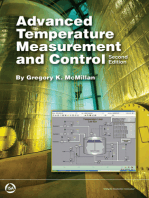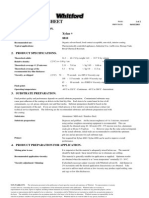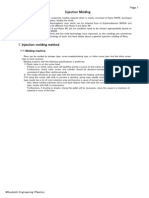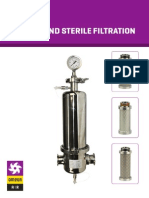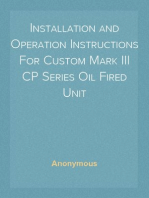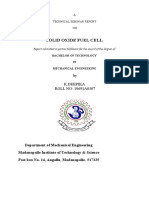Injectionguide PDF
Injectionguide PDF
Uploaded by
AgnieszkaCopyright:
Available Formats
Injectionguide PDF
Injectionguide PDF
Uploaded by
AgnieszkaOriginal Title
Copyright
Available Formats
Share this document
Did you find this document useful?
Is this content inappropriate?
Copyright:
Available Formats
Injectionguide PDF
Injectionguide PDF
Uploaded by
AgnieszkaCopyright:
Available Formats
PMMA ALTUGLAS granules
INJECTION MOLDING GUIDELINE
These suggestions and data are based on information we believe to be reliable.
They are offered in good faith,but without guarantee,as conditions and
methods of use of our products are beyond our control.Atoglas makes no
warranties,either express or implied,as to accuracy of these data.
Atoglas expressly disclaims any implied warranty of fitness for a particular
purpose.We recommend that the prospective user determine the suitability of
our material and suggestions before adopting them on a commercial scale.
Edition 3/ 10.02.2004 / 21 pages
1/21
Injection moulding processing of Altuglas granules
Influence of the parameters vs. visible defects
Processing parameters
Pre drying of the granules
Handling of the granules
Melt temperature
Mould temperature
Pressure / Hold pressure
Back pressure and screw speed
Injection speed
8
9
Tool design : runner / gate
Tool design: cavity
10
Tool design: hot runners
2/21
Visible defects
Silver streaks Little bubbles
(high thick item)
Whitening / white and coloured
streaks/ inclusion
Silver streaks / white bubbles
wrong filling/crazing
Transparent bubbles/wrong
filling
Wrong filling / transparent
bubble breaking / crazing
Black streaks/ irregular dosing/
overheating
Splash / silver streaks /black
streaks /orientation/wrong filling
Wrong filling / jet filling /
Demoulding / warpage/wrong
filling / item breakiage
Splash / overheating / silver
Streaks /wrong filling
Pre drying of the Altuglas granules
Pre drying is an apparently simple process it is in practice the source of operational
errors. The main reason being that the degree of moisture in the granule before it is
dried and the humidity level finally reached are usually unknown.
This problem can be solved ,even without moisture testing equipment, by defining the
following parameters:
AIR HUMIDITY
DRYING TEMPERATURE
DRYING TIME
PMMA granules must be subjected to very accurate treatment to avoid contamination
caused by dust and other polluting agents. Contamination during drying operation is
mainly due to polymers tendency to electrostatic charges resulting from friction and to
the granules abrading action on the surfaces of contact. The material used in the
construction of pre- drying system must be selected carefully. Soft or easily alterable
material s must be avoided.
Material recommended for ancillaries : iron steel
During drying in forced ventilation dryers the air must be purified and filtered to avoid the
deposition of impurities on the polymer.
Since Altuglas granules have a medium level hygroscopic behaviour, moisture is
absorbed within the granules as well as on the surface. The moisture content of an air
exposed granule increases constantly until it reaches an equilibrium which depends on
the level of relative humidity in the air.
3/21
Pre drying of the Altuglas granules
AIR HUMIDITY
The ambient air can be contains some quantity of the water up to saturation, quantity of
water increase in function of the ambient temperature.
At 20C 1 kg of air contains
14.7 gr of water
At 30C 1 Kg of air contains
20 gr of water
RELATIVE HUMIDITY OF THE AIR
The relative humidity of the air is the real ratio that defines the water quantity into air at
defined ambient conditions
Relative ambient humidity
100%
70%
50%
Ambient temperature
20C
20C
20C
Water content into air
14.7 gr
11.7 gr.
7.35 gr.
Using standard drying system for granules the operative conditions are not completely
controlled because ambient conditions are variables. It is normal, in fact, that using the
same parameters for drying we have not the same results during the various production.
DEW POINT
The content of absolute humidity in the air is usually referred to as dew point which is
temperature at which humidity begin to condense. This is not an absolute value but must
be related to a precise temperature. Lower dew point = greater drying speed and lower
the level of residual moisture into granules.
Air temperature
+ 15 C
0 C
- 40 C
Water in 1 Kg of air
10 gr
4.0 gr
0.08 gr.
The dew point can be reduced considerably by using the de- humidifying filters, the most
efficient filters, i.e. able to reduce the dew point to below 0 C, are silica gel based filters
or molecular sieve filters with an air recycling system. The best results, dew point up to
40 C, are obtained when using a silica gel filter with cooler (higher temperature = lower
efficiency of the gel)
4/21
Pre drying of the Altuglas granules
OPERATIVE CONDITIONS
DRYING TEMPERATURE / TIME
De-humidifying
Traditional
Time/hours
VM - VML
V 920
V 920T
V 825T- HID
V044 V045
65 70 C
70 75 C
70 75 C
80 85 C
75 80 C
70 75 C
75 80 C
75 80 C
85 90 C
80 85 C
24
24
24
24
24
MI 2T
MI 4T
MI 7T
DRT
HFI 7
HFI 10
80 85 C
80 85 C
75 80 C
75 80 C
70 75 C
70 75 C
85 90 C
85 90C
80 85 C
80 85 C
75 80 C
75 80 C
24
24
24
24
24
24
HT 121
327
VOD
95 100 C
70 75 C
70 75 C
100 105 C
75 80 C
75 80 C
24
24
2-4
Altugflas
5/21
Pre drying of the Altuglas granules
Effect of the air humidity vs drying performances
% residual moisture into granules
0,35
0,3
0,25
A
B
C
0,2
0,15
0,1
0,05
0
1
drying time (hours)
A= air at 70% U.R.
B = air at 50% U.R.
C = air at dew point 40 C
Level of residual moisture into granules vs. processability
Technology
Level of criticity
Residual
moisture %
Extrusion with venting
Injection moulding venting
Injection moulding
Injection moulding
Injection moulding
Extrusion without venting
Critical level for processing
Critical level for processing
Level to produce normally
Level to obtaine good performances
Level to obtaine very good performances
Level to obtaine good performances
> 0.25
> 0.15
0.10
0.07
0.05
0.03
6/21
Handling of the Altuglas granules
The excellent clarity of Altuglas resin can be jeopartized with poor material
handling.
We seal our resins in heavy gauge, moisture resistant , PE lined drums or
carton boxes.
When loading hoppers, the container lid should be wiped clean to avoid
contamination.
The container should be kept covered during the run to keep dust and dirt
from contaminating the contents of the container.
Container should be resealed when not in use
Hopper loaders must be disassembled and cleaned before loading if
previously used for anything other than acrylic. Similarly, the machine hopper
should be should be vacuumed and wiped down before use.
A small amount of PS or other plastics resins as PC or SAN can
contaminate an entire hopper load.
Drying ovens must also be checked to avoid contamination from blowing
fines and stray resins.
Considering high hardness of the acrylic granules the material used for
hopper, tubes for pneumatic transport and generally for all parts in contact
with granules, must be iron steel in order to avoid contamination by friction.
7/21
Melt temperature for Altuglas granules
In injection moulding process the residence time of the material into cylinder and the
thermal profile are the parameter in order to have a real temperature of the material or
melt temperature.
The melt temperature has a very important rule in processing because permits the control
of the other parameters in order to works in very good processability conditions.
The residence time evaluation is very important parameter to determine the values of the
profile temperatures of the cylinder to obtain a correct melt temperature for each Oroglas
type. In fact in some case is necessary to change the cylinder capacity in order to works
without degradation problems.
Evaluation of residence time
The first data at disposal is the real injection capacity (normally for PS) that is function of
diameter of the cylinder. Using the data concerning cylinder capacity and the density of
melt of the other resins is possible to obtain an accurate data about real injection capacity.
Real injection capacity = Real injection volume polymer density (at melt temperature)
Polymer
ABS
PA
PC
PE
PMMA
PP
PS
SAN
Density
gr/cm3
0.88
0.91
0.97
0.71
0.95
0.73
0.91
0.88
Residence time
real injection capacity 2
Item weight
Where : real injection capacity /item weight = gr.
8/21
total cycle
60
Total cycle = sec.
Melt temperature for Altuglas granules
The residence time in injection moulding of Altuglas granules has a very
important rule in order to obtain item at maximum quality level.
Using for example Altuglas V 825T at 245C ( usual melt temperature) we have the
following limit:
Residence time < 1 minute: not correct plasticating
presence on the
items of the following defects: flow lines orange skin filling problems -
Residence time > 6 7 minutes : Degradation or depolymerisation
presence on the items of bubbles transparent or white silver streaks black streaks
The sequence of the defects is usually the following:
1. Silver streaks (1-2 moulded items) for overheating
2. Bubbles and black streaks (2-3 moulded item) for degradation.
3. Bubbles black streaks white bubbles after phases 1-2 principle depolymerisation.
Evaluation of real melt temperature
To evaluate correctly the real melt temperature is necessary to use the following method:
- take the value when the injection machine works in production condition for 1020
moulded items ( about 10 20 minutes)
- purge the cylinder and evaluate the melt temperature by thermometer introducing the
sensor into core of molten material. If the sensor is located into nozzle ,the melt
temperature will be higher of 5-10 C than real value because friction due to injection.
Ideal melt temperature for Altuglas grades
Altuglas
Melt C
VM
200
Altuglas
Melt C
MI 2T
235
V 920
225
MI4T
235
V 920T
230
VOD
230
MI7T
240
V 825 T
240
DRT
245
9/21
V044 V045
245
HFI7
225
HFI10
235
HT 121
245
327
235
Mould temperature for Altuglas granules
The mould temperature is extremely important since it affects the overall properties of the
moulded part (visually and physical) and the filling of the cavity.
The effect on the item for not correct mould temperature are :
LOW MOULD TEMPERATURE
filling problems of the cavity
orientation and stress into moulded item
bad surface of the item (orange skin flow lines)
- reason of the use of the low mould temperature is the total cycle reduction but the final
result normally is to decrease the real production because higher reject level of the items
HIGH MOULD TEMPERATURE
good filling of the mould
higher physical properties of the final item
very long cooling time before ejection of the item
reason of the use of high mould temperature is to increase performances of the photometry,
the thermal properties and chemical resistance.
MOULD TEMPERATURE for Altuglas grades
Use of the oil as fluid for mould cooling system is recommended in order to control very well
the temperature.
Altuglas grade
VM - VML
V 920
V 920 T VOD
V 825 T
V0 44 V0 45
HT 121
MI 2T MI 4T
MI 7T
DRT
HF I 7 HFI 10
Mould temperature C
50 60
60 70
70 80
75 85
70 80
80 90
70 80
70 75
70 80
60 70
10/21
Pressure /hold pressure for Altuglas granules
Injection pressure phase
1. Increasing
2. Maximum
Filling sprue runner Complete filling of
and partially cavity
the cavity.
3. Holding
Complete filling of
the item to obtain:
visual aspect
physical properties
4. Residual
Residual pressure on
the mould wall after
Injection phases.
Low influence
1. In this phase pressure have not particular influence on the moulded item because filling of
the mould is not completed.
2. This phase is very important as level of pressure and application time because correlated
with complete filling of the mould and clamping force on the mould.
Low level and /or time
Problem to fill the mould cavity
High level and /or time
Higher level than necessary of clamping force
Opening of the mould with presence of the plastic material in parting line.
3. Holding pressure as level and /or application time is the key parameter to obtain the
maximum of performances on moulded item from visual and physical point of view. To have
a real effect on the moulded part, ensure an extra cushion of polymer after injection.
Low level and/or time
Surface irregularities
Excessive linear shrinkage
Transparent irregular bubbles
High level and /or time
Internal stress of the moulded part (crazing)
Demoulding problem (breakage in ejection phase or spontaneous)
11/21
Back pressure and screw speed for Altuglas granules
Back pressure
Moderate back pressure must be applied during feeding to confer an appropriate level of
polymer packing during feeding. This value usually between 10 15% of the pressure
available on the machine.
Low level
Air inclusion during feeding with presence of black streaks on moulded item
High level
High friction on the granules with possible degradation of the polymer by uncontrolled
overheating.
Screw rotation speed
The number of screw turning varies in relation to its shape and diameter.
The rotation speed must be chosen to ensure that feeding is constant. Generally the most
commonly used range is between 40 80 RPM
Low level
Long feeding time with problem to remain in acceptable total cycle
High level
Big problem on the screw rotation during feeding up to block of the screw due to excessive
friction
Uncontrolled overheating with presence of bubble and /or silver streaks on moulded item
12/21
Injection speed for Altuglas granules
Injection speed varies according to the thickness of the item to be moulded.
Generally lower speeds are used for very thick item, higher speeds for thinner
items so that the mould is filled before the melted polymer is cooled.
Low level
Problem to fill correctly the item
More evidence welding and flow marks
High level
Excessive friction into cylinder nozzle gate with presence of :
- splash uncontrolled (mostly with hot runners)
bubbles and or burned polymer at the end of path length due to
overheating
- black streaks in presence of little quantity of air trapped during feeding
The value of injection speed is usually between 20 50 mm/sec
13/21
Tool design : traditional mould runner /gate /cavity
SPRUE : connects nozzle of cylinder to runner system
RUNNER : channels which transport material from sprue
to the parts.Usually quite thick to avoid pressure loss and
high shear.
GATE: transition between runner and part. Usually small
this freezes first and once frozen the holding pressure
is removed
14/21
Tool design : runner / gate for Altuglas granules
Runner
Circular or trapezoidal rounded edges distribution runner are generally used since these
facilitate the flow on the melted polymer, at the same time avoiding narrow curves or
sharp changes of direction in the runners.
However, it is important, within the limit allocated, as far as the number and position of the
cavities is concerned, to use the shortest possible path.
This results in maximum flexibility during the filling of the cavity together with the
production of good quality items (both aesthetically and physical properties)
The size of runner depends on the shape of the item, generally, 2 4 mm. thick items
require a primary runner with a 3.5 5 mm. diameter whereas ticker items require a
7 15 mm diameter. The diameter of the secondary runner are usually 1 2 mm lower
than primary runner.
Gate (injection point)
Gate size, shape and placement affect the flow pattern of material entering the mould and
may influence the temperature of the melted material, fill time and overall part quality.
In parts of variable cross section, the gate should be located in the thickest section to
minimize fill problem. Generally, the gate thickness should be 50 60 % of the thickness
of item for standard PMMA and 60 70 % for impact PMMA. Concerning centre gate or
submarine plug the gate diameter will be between 0.8 2.0 mm.
Runner and gate are the feeding system of the cavity, the typical defects
with lower dimension in mould project are :
Use of high melt temperature to fill the mould with problem of overheating and/or
degradation.
Use of high injection pressure values to fill the mould with problem of tension into item
Bad quality of item aesthetic with presence of welding lines, orange skin, and usually very
poor physical properties of the item : (i.e. bad optical performance in captadiotric part)
15/21
GATES for PMMA
SPRUE gate : provide simplicity for single cavity
moulds and simmetry on circular shapes.
Suitable for thick sections.
PIN gate : very small circular gate.
used for thin section
easy to remove
SIDE gate : simple and can be used
for multicavity moulds.
TAB gate : avoids jetting and allows area of
highest strain to be removed.
16/21
GATES for PMMA
FLASH gate : provides simultaneous
filling over the whole length of the mould
to given even shrinkage along the length
EXTERNAL RING gate : used for
multicavity concentric mouldings
of ring shape or where a diaphram
gate cannot be used.
INTERNAL RING gate : similar to diaphram
gate, used for moulds with large internal
diameters.
17/21
GATES for PMMA
DIAPHRAM gate : used for single cavity
concentric mouldings of ring shape with
medium or small internal diameter.
TUNNEL or SUBMARINE gate :
provides automatic de - gating
only suitable for thin section
MULTI - POINT gate : similar to diaphram
gate but may produces weld lines
18/21
Tool design: cavity for Altuglas granules
When calculating the dimension of the cavity the shrinkage of the polymer during
processing must be taken into account.
Moreover, the surface of the cavity must be mirror polished to obtain a very good aesthetic
aspect of the final item.
It is important to avoid , as much as possible, undercut and sharp edges to ensure good
demoulding and to avoid breaking the items during use.
All the moulds must be fitted with thermostating fluid runners in order to improve filling ,
aesthetic and physical properties of the items.
The setting and shape runners varies according to the item to be moulded and must be
designed to ensure even cavity filling and uniform cooling.
Air outlets around the cavity must also be included. These outlets must be large enough to
ensure fast autflow of air, thus avoiding dead areas or stagnation during cavity filling which
could result in surface faults due to localized overheating.
Correct cavity and feeding system design permits to work with a large processing
window avoiding the problems as :
- overheating (silver streaks bubbles)
- degradation (white bubbles black streaks)
- overpacking (residual stress)
-
aesthetic of the item (orange skin flow lines )
- physical problems (irregular shrinkage , lower use temperature)
-
breakage ( during ejection or in use condition)
19/21
Tool design : hot runner system
free runner
good for PMMA
pneumatic valve
very good for PMMA
Mold with hot runners
Torpedo system
NOT GOOD for PMMA
20/21
Tool design: hot runners for Altuglas granules
Hot runners system are widely used for acrylic polymers, especially in high
productive sectors such as the automotive, household appliance, lighting
industrie.
The advantages of this technology can be summarized as follows:
Eliminating the removal of the feeding system thus recovering polymer
Reduce pressure loss during filling as a result of shorter path. Therefore,
better control of the filling process and reduced cycles due to lower injected
polymer volume are obtained.
The disavantages generally are the follows:
Changing colour is a longer and more delicate process
More care and greater skills are required in handling the equipment
The problems which usually arise during moulding are:
Streaks as a result of uncontrolled overheating into hot runner
Weld lines due to uncontrolled melt temperature into hot runner
The problem of overheating is a direct result of friction stress undergone by
the polymer in the narrow part of feeding system and is strictly related to both
the systems geometry and to processing condition (temperature, injection
speed profile)
The weld lines are more evident in torpedo system where the polymer must
flow into the support spokes.
If the melted polymer is not homogeneous, weld lines, which join when the
material is relatively cool, are produced on the finished item.
21/21
You might also like
- Advanced Temperature Measurement and Control, Second EditionFrom EverandAdvanced Temperature Measurement and Control, Second EditionNo ratings yet
- Rise of The Guardians Script at IMSDbDocument125 pagesRise of The Guardians Script at IMSDbFloraNo ratings yet
- Pathways LS1 2e Test ScriptDocument27 pagesPathways LS1 2e Test ScriptdieuanhNo ratings yet
- Desmopan TPU ProcessingDocument48 pagesDesmopan TPU ProcessingA Mahmood100% (1)
- Factors Influencing The Grinding EfficiencyDocument27 pagesFactors Influencing The Grinding Efficiencynoelbaba71100% (2)
- Secador SchulzDocument16 pagesSecador SchulzSantiagoAlpala100% (1)
- Engineering Polymers: The Top Ten' Moulding Problems: Chapter 1. Moisture in The GranulesDocument30 pagesEngineering Polymers: The Top Ten' Moulding Problems: Chapter 1. Moisture in The GranulesMamdouh MasoudNo ratings yet
- 8810Document2 pages8810Sikander Aleem100% (1)
- Industrial Applications of Infrared Thermography: How Infrared Analysis Can be Used to Improve Equipment InspectionFrom EverandIndustrial Applications of Infrared Thermography: How Infrared Analysis Can be Used to Improve Equipment InspectionRating: 4.5 out of 5 stars4.5/5 (3)
- Soldering electronic circuits: Beginner's guideFrom EverandSoldering electronic circuits: Beginner's guideRating: 4.5 out of 5 stars4.5/5 (10)
- Pakistan Army Martyrs Siachin GlacierDocument13 pagesPakistan Army Martyrs Siachin GlacierXeric50% (2)
- Reading Comprehension Outline 3-2Document5 pagesReading Comprehension Outline 3-2Divjyot88No ratings yet
- Elastollan Processing Recommendations PDFDocument28 pagesElastollan Processing Recommendations PDFNicolae MariusNo ratings yet
- Equipment and System Dehydrating, Charging, and Testing: Related Commercial ResourcesDocument7 pagesEquipment and System Dehydrating, Charging, and Testing: Related Commercial ResourcesBurning TrainNo ratings yet
- AltuglasDocument4 pagesAltuglasBhanuNo ratings yet
- Phenoline 1205 PDS 9-06 PDFDocument2 pagesPhenoline 1205 PDS 9-06 PDFttr_1947No ratings yet
- Chemical Resistance GuideDocument36 pagesChemical Resistance GuideHeiner PalaciosNo ratings yet
- Ar 2030 Kte 9 TXDocument4 pagesAr 2030 Kte 9 TXbizhanjNo ratings yet
- Injection MoldingDocument17 pagesInjection MoldingAnoj pahathkumburaNo ratings yet
- SteamlocDocument8 pagesSteamlocstuntmanzNo ratings yet
- Delrin® Acetal Homopolymer Resin - Molding TipsDocument4 pagesDelrin® Acetal Homopolymer Resin - Molding TipsashkansoheylNo ratings yet
- TB-00098 (ASTM D2386 - The Proper Apparatus Setup)Document4 pagesTB-00098 (ASTM D2386 - The Proper Apparatus Setup)Balqis IzzatieNo ratings yet
- M4 ManualDocument20 pagesM4 Manualamit64007No ratings yet
- Chemflake Special - English (Uk) - Issued.08.01.2010Document5 pagesChemflake Special - English (Uk) - Issued.08.01.2010Mohamed FaragNo ratings yet
- Muki Z 2001 - TDSDocument4 pagesMuki Z 2001 - TDSshameelNo ratings yet
- OMEGA AIR - Process and Sterile Filtration - EnglishDocument12 pagesOMEGA AIR - Process and Sterile Filtration - EnglishOMEGA AIR d.o.o. LjubljanaNo ratings yet
- Isoplast - Processing GuidelinesDocument12 pagesIsoplast - Processing GuidelinesFrank LiaoNo ratings yet
- TDS - CHEMFLAKE CV - English (Uk) - Issued.13.04.200Document4 pagesTDS - CHEMFLAKE CV - English (Uk) - Issued.13.04.200wey5316No ratings yet
- Processing Data BASF B 4406Document3 pagesProcessing Data BASF B 4406sygabrielaNo ratings yet
- Autoclave-21L 77000001189Document28 pagesAutoclave-21L 77000001189Trường Vĩ HuỳnhNo ratings yet
- Pds Aircol PDDocument2 pagesPds Aircol PDtribolasNo ratings yet
- PA-ABS PROCESSING ENGDocument3 pagesPA-ABS PROCESSING ENGNguyen Dinh VinhNo ratings yet
- 7686 Sigmacap Coaltar EPDocument3 pages7686 Sigmacap Coaltar EPDetoned StonedNo ratings yet
- Processing FluoroelastomersDocument8 pagesProcessing FluoroelastomersGaurav VoraNo ratings yet
- Amercoat 370Document3 pagesAmercoat 370Victor Hugo Bustos Beltran100% (1)
- 7001 - E-Notes On Injection MouldingDocument8 pages7001 - E-Notes On Injection MouldingStåle EliassenNo ratings yet
- Sigmadur Gloss: Description PRINCIPAL CHARACTERISTICS - Unlimited RecoatableDocument4 pagesSigmadur Gloss: Description PRINCIPAL CHARACTERISTICS - Unlimited RecoatableKopnang AristideNo ratings yet
- Sigma Cover 510Document4 pagesSigma Cover 510supriadi90315100% (1)
- SigmaCover 280Document5 pagesSigmaCover 280ajuhaseenNo ratings yet
- Demag Liquid Silicone Rubber Inj Moulding PDFDocument8 pagesDemag Liquid Silicone Rubber Inj Moulding PDFMed AliNo ratings yet
- Sigmaguard 720Document4 pagesSigmaguard 720Danny Durham100% (1)
- Sigmadur 520 (English)Document4 pagesSigmadur 520 (English)KyNo ratings yet
- 7479 - Sigmacover 510Document0 pages7479 - Sigmacover 510eraswastaNo ratings yet
- PLA NatureWorksDocument3 pagesPLA NatureWorkstblos100% (1)
- Solvalitt TDSDocument4 pagesSolvalitt TDSphillipskincaidNo ratings yet
- Amer240 Edge CoverageDocument4 pagesAmer240 Edge CoverageEugene DoyleNo ratings yet
- Ficha Tecnica Ultramid B3WG5Document2 pagesFicha Tecnica Ultramid B3WG5manaswin404No ratings yet
- Sheet Extrusion Processing Guide: 1.0 Safety and Handling PrecautionsDocument8 pagesSheet Extrusion Processing Guide: 1.0 Safety and Handling PrecautionsbobNo ratings yet
- (LEM ADHESIVE RTV 133) Tds - RTV - 133Document4 pages(LEM ADHESIVE RTV 133) Tds - RTV - 133wikeseptiani17No ratings yet
- Factors Influencing The Grinding EfficiencyDocument27 pagesFactors Influencing The Grinding Efficiencygrameshkreddy2013No ratings yet
- Why Do Compressed Air Systems Need Drying?Document4 pagesWhy Do Compressed Air Systems Need Drying?maddukuri jagadeesh babuNo ratings yet
- Tds - Alkydprimer - Issued.31.08.2005Document4 pagesTds - Alkydprimer - Issued.31.08.2005wey5316No ratings yet
- PEEK-OPTIMA Processing Guide SecuredDocument0 pagesPEEK-OPTIMA Processing Guide SecuredAngel LagrañaNo ratings yet
- Om 340Document3 pagesOm 340RNo ratings yet
- Eco Micron FitDocument4 pagesEco Micron FitNicholas Jeffrey DaviesNo ratings yet
- Etatron Chemical Resistance Chart UploadedDocument35 pagesEtatron Chemical Resistance Chart Uploadedatiq124No ratings yet
- Foaming Tendencies of Oil TestsDocument8 pagesFoaming Tendencies of Oil TestsJustin EvansNo ratings yet
- Sulphonation (Ballestra)Document20 pagesSulphonation (Ballestra)cortezt100% (3)
- TDS - Baltoflake S2000 - English (Uk) - Issued.26.11.2010Document4 pagesTDS - Baltoflake S2000 - English (Uk) - Issued.26.11.2010rezza182No ratings yet
- DryKeep Booklet44919 June2012Document20 pagesDryKeep Booklet44919 June2012Ariel Martinez NNo ratings yet
- Inside the Pill Bottle: A Comprehensive Guide to the Pharmaceutical IndustryFrom EverandInside the Pill Bottle: A Comprehensive Guide to the Pharmaceutical IndustryNo ratings yet
- Installation and Operation Instructions For Custom Mark III CP Series Oil Fired UnitFrom EverandInstallation and Operation Instructions For Custom Mark III CP Series Oil Fired UnitNo ratings yet
- XH360L VDocument5 pagesXH360L VJorge CantanteNo ratings yet
- Frontal Systems MechanicsDocument22 pagesFrontal Systems Mechanics294rahulNo ratings yet
- Wind Turbine Power Plant Seminar ReportDocument27 pagesWind Turbine Power Plant Seminar Reportpiyush138090No ratings yet
- Case Study Joelo GuiebDocument3 pagesCase Study Joelo GuiebJuan Makasalanan50% (2)
- Sugar Industry RecoveryDocument17 pagesSugar Industry Recoverys.sabapathyNo ratings yet
- Press Release On Enhanced Rainfall Activity Over Maharashtra Dated 21st July 2021Document10 pagesPress Release On Enhanced Rainfall Activity Over Maharashtra Dated 21st July 2021Balkrishna KambleNo ratings yet
- Daniel Bazikian - Online - Human Impacts On The Oceans Climate Change Digital Art Project Brainstorm and ResearchDocument5 pagesDaniel Bazikian - Online - Human Impacts On The Oceans Climate Change Digital Art Project Brainstorm and Researchapi-375161607No ratings yet
- Climate Change and Global WarmingDocument15 pagesClimate Change and Global WarmingJefri NicholasNo ratings yet
- Corrosion Survey - Maintenance Painting ProjectDocument8 pagesCorrosion Survey - Maintenance Painting ProjectAmit Nimbalkar100% (1)
- Towards Methods For Systematic Research On Big DataDocument10 pagesTowards Methods For Systematic Research On Big DataRosa Quelal MoraNo ratings yet
- The Day After Tomorrow (2004)Document3 pagesThe Day After Tomorrow (2004)RamramVasquezNo ratings yet
- 2013 Kedarnath DisasterDocument5 pages2013 Kedarnath Disasterisha patelNo ratings yet
- Executive Summary: BUS-511.1 Group-2Document16 pagesExecutive Summary: BUS-511.1 Group-2Onno Groher StanleyNo ratings yet
- hw4 SoDocument18 pageshw4 SoAbdu Abdoulaye100% (2)
- Die Hardest Pages 1-45Document46 pagesDie Hardest Pages 1-45Craig McInnesNo ratings yet
- Daily Express-10MayDocument47 pagesDaily Express-10MayvnaliniNo ratings yet
- Lyo ProcessDocument34 pagesLyo ProcessProf C.S.PurushothamanNo ratings yet
- OIV World Wine Production Outlook 2023Document9 pagesOIV World Wine Production Outlook 2023Tim MooreNo ratings yet
- Lighting DesignDocument34 pagesLighting DesignMitiMehta2290% (29)
- Ocean Motion - Science Learning HubDocument6 pagesOcean Motion - Science Learning HubThaiane SantosNo ratings yet
- RanchiDocument13 pagesRanchiSunil JaiswalNo ratings yet
- Word Order of AdverbsDocument6 pagesWord Order of AdverbsJohn Dave Fernandez Ulep100% (1)
- GSM Session1Document26 pagesGSM Session1Bindumadhavi NandakishoreNo ratings yet
- Gold Exp B2P U4 Skills Test ADocument3 pagesGold Exp B2P U4 Skills Test AEfraim GomesNo ratings yet
- Grammarway 4 C1 Units 1-3Document52 pagesGrammarway 4 C1 Units 1-3esthermuelaNo ratings yet
